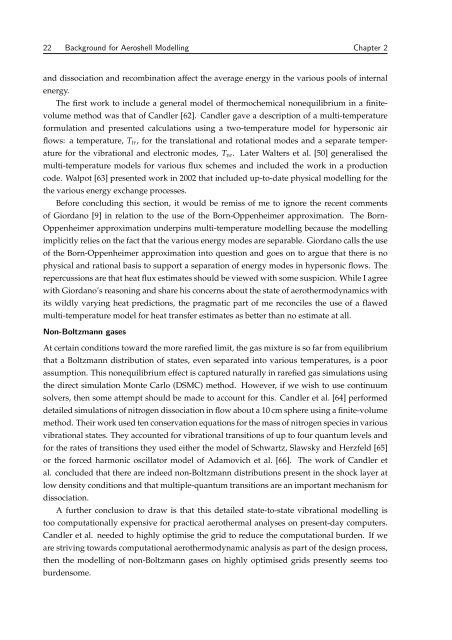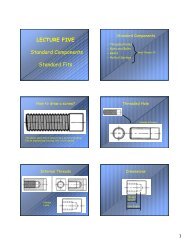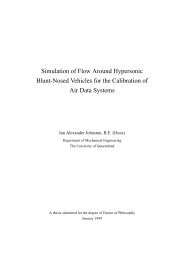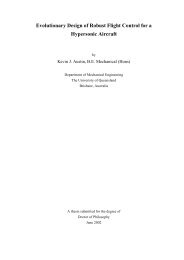Rowan-Gollan-PhD-Thesis - Mechanical Engineering - University of ...
Rowan-Gollan-PhD-Thesis - Mechanical Engineering - University of ...
Rowan-Gollan-PhD-Thesis - Mechanical Engineering - University of ...
You also want an ePaper? Increase the reach of your titles
YUMPU automatically turns print PDFs into web optimized ePapers that Google loves.
22 Background for Aeroshell Modelling Chapter 2<br />
and dissociation and recombination affect the average energy in the various pools <strong>of</strong> internal<br />
energy.<br />
The first work to include a general model <strong>of</strong> thermochemical nonequilibrium in a finite-<br />
volume method was that <strong>of</strong> Candler [62]. Candler gave a description <strong>of</strong> a multi-temperature<br />
formulation and presented calculations using a two-temperature model for hypersonic air<br />
flows: a temperature, Ttr, for the translational and rotational modes and a separate temper-<br />
ature for the vibrational and electronic modes, Tve. Later Walters et al. [50] generalised the<br />
multi-temperature models for various flux schemes and included the work in a production<br />
code. Walpot [63] presented work in 2002 that included up-to-date physical modelling for the<br />
the various energy exchange processes.<br />
Before concluding this section, it would be remiss <strong>of</strong> me to ignore the recent comments<br />
<strong>of</strong> Giordano [9] in relation to the use <strong>of</strong> the Born-Oppenheimer approximation. The Born-<br />
Oppenheimer approximation underpins multi-temperature modelling because the modelling<br />
implicitly relies on the fact that the various energy modes are separable. Giordano calls the use<br />
<strong>of</strong> the Born-Oppenheimer approximation into question and goes on to argue that there is no<br />
physical and rational basis to support a separation <strong>of</strong> energy modes in hypersonic flows. The<br />
repercussions are that heat flux estimates should be viewed with some suspicion. While I agree<br />
with Giordano’s reasoning and share his concerns about the state <strong>of</strong> aerothermodynamics with<br />
its wildly varying heat predictions, the pragmatic part <strong>of</strong> me reconciles the use <strong>of</strong> a flawed<br />
multi-temperature model for heat transfer estimates as better than no estimate at all.<br />
Non-Boltzmann gases<br />
At certain conditions toward the more rarefied limit, the gas mixture is so far from equilibrium<br />
that a Boltzmann distribution <strong>of</strong> states, even separated into various temperatures, is a poor<br />
assumption. This nonequilibrium effect is captured naturally in rarefied gas simulations using<br />
the direct simulation Monte Carlo (DSMC) method. However, if we wish to use continuum<br />
solvers, then some attempt should be made to account for this. Candler et al. [64] performed<br />
detailed simulations <strong>of</strong> nitrogen dissociation in flow about a 10 cm sphere using a finite-volume<br />
method. Their work used ten conservation equations for the mass <strong>of</strong> nitrogen species in various<br />
vibrational states. They accounted for vibrational transitions <strong>of</strong> up to four quantum levels and<br />
for the rates <strong>of</strong> transitions they used either the model <strong>of</strong> Schwartz, Slawsky and Herzfeld [65]<br />
or the forced harmonic oscillator model <strong>of</strong> Adamovich et al. [66]. The work <strong>of</strong> Candler et<br />
al. concluded that there are indeed non-Boltzmann distributions present in the shock layer at<br />
low density conditions and that multiple-quantum transitions are an important mechanism for<br />
dissociation.<br />
A further conclusion to draw is that this detailed state-to-state vibrational modelling is<br />
too computationally expensive for practical aerothermal analyses on present-day computers.<br />
Candler et al. needed to highly optimise the grid to reduce the computational burden. If we<br />
are striving towards computational aerothermodynamic analysis as part <strong>of</strong> the design process,<br />
then the modelling <strong>of</strong> non-Boltzmann gases on highly optimised grids presently seems too<br />
burdensome.







